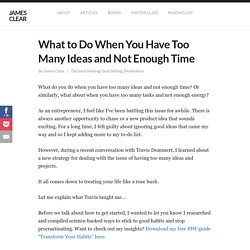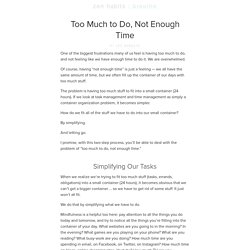

What to Do When You Have Too Many Ideas (And Not Enough Time) What do you do when you have too many ideas and not enough time?

Or similarly, what about when you have too many tasks and not enough energy? As an entrepreneur, I feel like I've been battling this issue for awhile. There is always another opportunity to chase or a new product idea that sounds exciting. For a long time, I felt guilty about ignoring good ideas that came my way and so I kept adding more to my to-do list. However, during a recent conversation with Travis Dommert, I learned about a new strategy for dealing with the issue of having too many ideas and projects. It all comes down to treating your life like a rose bush. Let me explain what Travis taught me… When the 80/20 Rule Fails: The Downside of Being Effective. When Your Plate is Too Full. By Leo Babauta Do you sometimes (or always) feel like you have too much to do and too little time to do it?

Consider an email I got from a student the other day: “… as the semester goes by, the harder it is to keep up with school. The thing is, I know I’d be able to do it if I didn’t have any extracurricular activities. I have a weekend job where I teach youths, a youth group where I currently lead social justice, and I was just asked by someone to lead prayer group.
“Right now, the only way to do everything is to sleep less and work more, but I noticed that I can’t do much when I haven’t gotten much sleep. I know this feeling, because that’s how I felt before I started simplifying my life. To this student, and to everyone else who feels this way, I’d say this: your plate is too full. The only answer, unless you want your health to decline (and that’s not good for anyone), is to start saying No. The Whys of Saying No. The Empty Container. Selective Focus. Choice. Estimation. Problem Solving. Goal. Commitment. Time Preference. Too Much to Do, Not Enough Time. By Leo Babauta One of the biggest frustrations many of us feel is having too much to do, and not feeling like we have enough time to do it.

We are overwhelmed. Of course, having “not enough time” is just a feeling — we all have the same amount of time, but we often fill up the container of our days with too much stuff. The problem is having too much stuff to fit into a small container (24 hours). If we look at task management and time management as simply a container organization problem, it becomes simpler. How do we fit all of the stuff we have to do into our small container? By simplifying. And letting go. I promise, with this two-step process, you’ll be able to deal with the problem of “too much to do, not enough time.” Simplifying Our Tasks When we realize we’re trying to fit too much stuff (tasks, errands, obligations) into a small container (24 hours), it becomes obvious that we can’t get a bigger container … so we have to get rid of some stuff. The Art of Letting Go. The Ivy Lee Method: The Daily Routine Experts Recommend for Peak Productivity. By 1918, Charles M.

Schwab was one of the richest men in the world. Schwab was the president of the Bethlehem Steel Corporation, the largest shipbuilder and the second-largest steel producer in America at the time. The famous inventor Thomas Edison once referred to Schwab as the “master hustler.” He was constantly seeking an edge over the competition. One day in 1918, in his quest to increase the efficiency of his team and discover better ways to get things done, Schwab arranged a meeting with a highly-respected productivity consultant named Ivy Lee.
Lee was a successful businessman in his own right and is widely remembered as a pioneer in the field of public relations. “Give me 15 minutes with each of your executives,” Lee replied. “How much will it cost me,” Schwab asked. “Nothing,” Lee said. The Ivy Lee Method During his 15 minutes with each executive, Lee explained his simple method for achieving peak productivity: What makes it so effective? On Managing Priorities Well. 40 Years of Stanford Research Found That People With This One Quality Are More Likely to Succeed. In the 1960s, a Stanford professor named Walter Mischel began conducting a series of important psychological studies.

During his experiments, Mischel and his team tested hundreds of children — most of them around the ages of 4 and 5 years old — and revealed what is now believed to be one of the most important characteristics for success in health, work, and life. Let’s talk about what happened and, more importantly, how you can use it. Free Bonus: Want to become better at delaying gratification?
I’ve created 3 great resources for you- my guide to getting started in just 2 minutes and my workbook for making any habit 1% better. Plus, an adorable video of some kid participating in the marshmallow experiment. The Marshmallow Experiment The experiment began by bringing each child into a private room, sitting them down in a chair, and placing a marshmallow on the table in front of them.